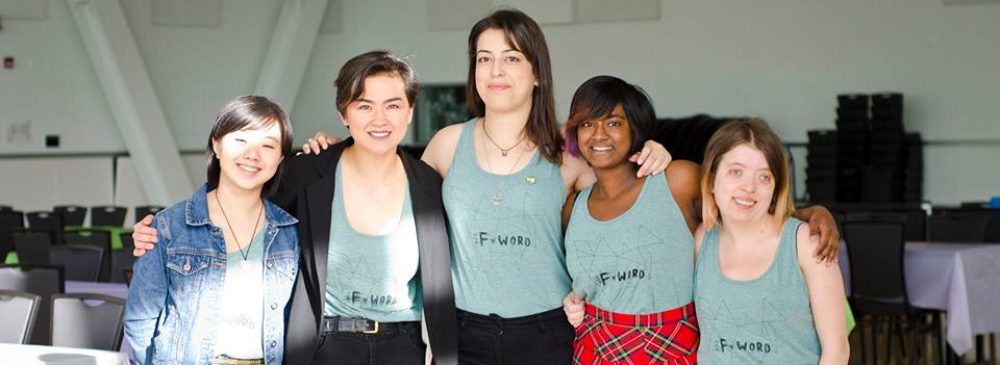A Guide for Student Activists (and anyone else who needs it)

From left to right: Mengxi Wang, Kaymi Yoon-Maxwell, Ghada Dbouba, Rashmi Abeysekra, Alison Watts-Grant. Photo credit: Leanna Favaro.
By Rashmi Abeysekera
Burnout: the mental, physical, and spiritual breakdown of a person caused by overwork and stress. It also often involves the gradual or abrupt disintegration of one’s motivation.
Most of us living in today’s (white supremacist, colonial, ableist, cisheteropartriarchal capitalist) world have experienced some form of burnout, and student activists happen to have a very special relationship with this dreadful phenomenon. But before diving too deeply into the subject of burnout, it’s important to look at who these student activists are.
So who exactly does the work of activism on university campuses fall upon?
In general, I see the work often falling upon those who need to do the work to survive; that is to say, those who are marginalized by the systems that create this work. Campuses are no exception.
Kaymi Yoon-Maxwell
In other words, on-campus activism (much like off-campus activism) is often shouldered by marginalized people who are the most disadvantaged by the unjust systems they are working to transform. The 2016 planning committee for the F-Word Conference is a good example of this. Our committee was comprised of 5 women: 4 of whom were women of color, and 4 who identified as queer. Most of us also struggled to work part-time jobs alongside our studies and personal lives. This is not to say that we did not also occupy positions of privilege, but to say that it was us–folks who inhabit multiple marginalized identities–who carried the weight and the legacy of the F-Word for that year.
So what does carrying that weight look like? According to Jasmine A. Mena and Annemarie Vaccaro’s research, in which they interviewed 6 queer-identifying student activists of color, “extracurricular responsibilities combined with heavy academic workloads, part-time jobs, and family demands put great amounts of pressure on the participants” (2011, 349). In line with their findings, “the presence of too many demands took a toll on the well being of participants” (Mena and Vaccaro 2011, 357). These demands reach beyond part-time jobs and course loads. In addition to exploring the hardships posed by student activism, Mena and Vaccaro’s work also illustrates how these hardships specifically impact marginalized folks who are also struggling with emotional demands of social oppression. So when we consider how “burnout can result in emotional and physical exhaustion and difficulty accomplishing goals”, we also need to consider who is the most vulnerable to this reality (Mena and Vaccaro 2011, 341).
What’s more, student activists–many of whom are marginalized folks–not only face social barriers, but also institutional barriers posed by the university. For example, Elizabeth Brulé’s work discusses the many different structural barriers to student activism at York University. She investigates the university’s instituted regulation of space as a way to prevent student activism (Brulé 2015, 162). For instance, in order to gain official access to spaces on York’s campus “some activist groups have altered their political rhetoric and activities — essentially depoliticizing their work” (Brulé 2015, 171). Thus, students’ radical efforts are stunted by the university.
In relation to the GRSJUSA, I think we would have difficulty accessing space on campus if we were not a department affiliated club. Due to our academic standing with the Social Justice Institute, for many years we have used the institute’s space to gather and hold events. In 2015, we became an official club of our school’s Alma Mater Society (AMS). This status granted us our own office space, locker, and access to booking event spaces in the AMS building. However, I believe that we may have faced challenges in gaining this status if we were not affiliated to the Social Justice Institute as an academic club.
I know that in the past social justice oriented groups, like the Feminist Club, have been rejected by the AMS for official club status.
Rashmi Abeysekera
There are so many barriers to student activism.
having to balance school work, working one or more jobs, social justice work, emotional labour… Navigating the ways all of these forms of work are entangled with one another makes volunteer work (work that is uncompensated and often under valued), hard to sustain.
Kaymi Yoon-Maxwell
To add salt to our wounds, for many of us, these barriers are accompanied by the weight of social and systemic oppression.
After organizing the F-Word, our committee was completely burned out. We had stretched our limits, spread ourselves thin, and allowed ourselves to collapse into a motivationless peril. Despite creating something that brought us tears of joy, something that we were proud of, and something that gave us hope… we also let ourselves down by giving in and accepting burnout as our inevitable fate. But this isn’t only our story. Activists, marginalized folks, and students alike experience burnout as a recurring pattern.
So how can we prevent burnout in ourselves and in our communities?
6 Ways to Avoid Burnout
1. Develop effective coping strategies that are suited to you
This is always a learning process because ‘self-care’ can transform and mean different things at different times.
Rashmi Abeysekera
Mena and Vaccaro tell us that “developing effective coping strategies facilitates wellbeing” (2011, 341). In order for your coping strategies to be effective, they should be personalized to you and your needs. This requires flexibility, as your needs may transform. For this reason, it’s important to come up with a variety of different coping strategies that you can use at different times. After all, the “effective use of a variety of coping strategies proactively wards off burnout” (Mena and Vaccaro 2011, 341).
2. Give your body what it wants
Burnout is not only about mental and emotional exhaustion, but also physical exhaustion. So often, in times of stress, we neglect our bodily needs. We let meals slide, we ‘forget’ to give ourselves physical exercise, and we basically pump our veins with caffeine… but we deserve better than that.
Even when you’re tempted to neglect your body, remind yourself that you deserve good health by giving it what it wants and what it needs.
3. Create and nurture your community and support networks
Community is key. Even if you’re someone who is more introverted, it is important to map out your support networks for the times in which you need them. In regards to socially disadvantaged and oppressed folks, Mena and Vaccaro found that “consistent social support among individuals with multiple minority status is especially important due to the negative impact of ongoing oppression and marginalization” (2011, 342).
Finding, building, and nurturing our communities and support networks is one of the best ways to take care of ourselves (and others).
4. Leverage your privilege!
Burnout tends to hit communities like the plague. If you carry certain privileges that other members of your community don’t, leverage your privilege to help lift the weight from their shoulders.
Alison Watts-Grant is an A+ example of this tactic. During our time organizing the 2016 F-Word Conference, she recognized that many of us had to work part-time jobs while she did not. Because she acknowledged this as an added stress and hardship for us, she often offered to take on a heavier workload as part of the organizing committee (which was such a relief!).
As mentioned before, avoiding burnout is not always an individual endeavor. It’s a communal endeavor. Look out for the people around you, and help them avoid burnout if you can.
5. If the plane’s going down, put on your own oxygen mask first
While supporting each other is extremely important, it’s also important to know your limits. From Mena and Vaccaro’s study, “participants learned that until they took care of themselves, they were unlikely to be effective activists or activist leaders” (2011, 356). Basically, you can’t help others until you help yourself. Before offering to support someone, make sure you’re taken care of too.
The fight is long, and I need a sustainable mind-body-spirit-heart for it. Self-care is one of the most radical things a feminist could do, I remind myself of that when I hesitate to take care of myself.
Mengxi Wang
6. Cut yourself some slack! You’re doing just fine
I need to work on not feeling bad or guilty when doing things to take care of myself and learn to enjoy things when I’m taking a break from work.
Kaymi Yoon-Maxwell
It’s not easy living in this (white supremacist, colonial, ableist, cisheteropartriarchal capitalist) world. Just the fact that you’re here is incredible. *Applause* A++ for you!
One of the worst things about burnout is the guilt. Yes, the guilt. We feel guilty for coming to a place where we are mentally, spiritually, and physically unable to continue our work, where we are undermotivated, and beaten down. We feel guilty for not spending the extra time on that paper, going the march, attending that meeting, or covering our co-workers shift… but you know what? I don’t think we should.
Go easy on yourself. Sometimes we can’t help it. Sometimes no matter what we do, burnout comes knocking at our door (more like breaking down our door…). So, sometimes it’s ok to be worn out… and in those times, it’s perfectly ok to take care of yourself.
A Labor of Love
A good note to end on rests with Natasha Cox’s 2014 piece where she discusses the ways in which queer student activists of color have to navigate multiple forms of oppression within academia and “regularly feel frustrated or overwhelmed in their efforts to succeed academically, while simultaneously helping others.” She talks about compassion fatigue, self-preservation, acts of political warfare, and setting priorities and boundaries. She reminds us that our work is “a labor of love” (Cox 2014). And despite the many obstacles, we are more than capable of developing “strengths, resilience, and ways of coping” (Cox 2014).
